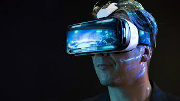Four Ways Virtual Reality Will Change Big Data

By Paul Sciglar -We are living in an age of big data. In this era of ever-increasing information, we’re collecting data at an astonishing rate, but not necessarily understanding it. At present, big data is an unwieldy beast — one that is often unorganized and uncommonly complicated to digest. Traditional bar graphs and pie charts on 2D screens simply aren’t cutting it. They aren’t allowing us to effectively process large data sets. In fact, according to Forbes, our eyes are limited to processing a mere 100 bytes of information a second on a traditional computer screen. We need new technologies to solve big data’s manifold challenges, and thankfully, virtual reality may be addressing them.
Virtual reality, or VR, has been around, in some form, since the 1990s. It is only recently, however, that commercial and industrial ventures in VR have become viable. In recent years, virtual reality technologies have proliferated at an incredible rate with over one million people using the Samsung VR headset last year. VR has already seeped into video gaming, film and even social media. Its ability to propel users into 3D worlds is not only exciting, it’s proving to be extremely useful. Visualization is crucial to understanding data, and VR provides users with the ability to immerse themselves in data in a more natural and intuitive way. As you can imagine, with this revolution in big data visualization come some pretty big changes.
Here are the four ways VR will change big data:
Big Data Will Be Immersive
Visualizing large sets of data on 2D screens is a near impossible task. VR offers an alternative to the traditional viewing of data, however. What if you could stand in the center of massive data, step towards one data point, then fly towards an outlier? With VR you’re able to — quite literally — step into your data. Data models surround you. You can peak around spirals of floating data or view data points at different angles.
Large companies with considerable means have already used VR’s immersive capabilities to solve complex problems. A few years ago, Goodyear, with the help of Dr. Creve Maples, one of VR’s earliest advocates, utilized virtual reality to answer the question of why their tires were underperforming in races. Dr. Maples and his team created a virtual environment in which Goodyear’s vehicles and tires were replicated. They exaggerated changes in their tires, such as tire pressure changes, in real time. This immersion resulted in important data being much easier to recognize, and Goodyear quickly found out what was making their tires so deficient.
Analysis Will Become Interactive
Interactivity is the key to understanding big data. Immersion doesn’t mean much without the ability to handle data dynamically. For decades we have been employing static data models to understand dynamic data, but VR has given us the ability to process data dynamically, too. With VR, you are be able to reach out and touch data. Big data will become a tactile experience, something that makes it easier to comprehend — and manipulate.
We’ll Learn More, More Quickly
When data is presented in a more natural and immersive way, it’s easier for humans to comprehend. It even increases the amount of data we’re able to process in a given moment, and increases discovery. According to GE, VR has the capability to organize information in a more “empathetic” way, in that 3D data is less likely to overload a user’s mind with incomprehensible facts and figures.
Cross Referencing Data Will Become Ultra-Efficient
Master of Pie showcased their VR technology, one employed by a massive longitudinal study, Children of the 1990s, last year with great success. In an extensive demo of their project, they highlight the user’s ability to alter their data instantly. With a few waves of VR wands, you’re capable of stacking relevant data, paring data down and creating visual cues like blinking dots to cross-reference instantly. According to one big data researcher who was able to test the technology, she was able to see four times as much information “at a glance.”
Big data is already a big part of our lives. VR could help reshape our relationship to it, and perhaps enhance our ability to analyze it. VR is making data as immersive and interactive as a first-person video game. What’s more, it’s increasing the amount of information we can ingest, and bettering our understanding of it, too. As the amount of information available to us expands, we must find more efficient ways of making sense of it, and VR might help us do just that.
Category: Uncategorized






